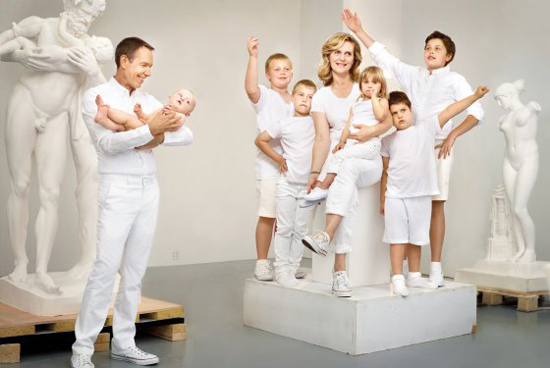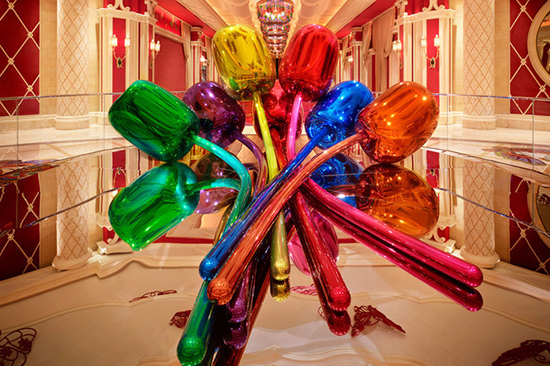“Hi, I’m Jeff Koons,” he whispered over the velvet rope with a syrupy smile, he of the Brooks Bros. coat, the sonorous voice. The young girl with the clipboard scanned the pages up and down. “I’m sorry, I don’t see your name.”
“Jeff Koons,” he repeated, more quietly so as not to embarrass her, “I’m supposed to go in.”
It was the spring of 1985 and the Palladium night club on 14th Street had been taken over by Steve Rubell, the former owner of Studio 54, and hundreds were on the sidewalk hoping to squirm past the gate.
But Jeff Koons wasn’t on the list, he wasn’t on any list, he wasn’t on the list to get on the list; he’d been crossed off most lists. Thirty years old, knocking around the New York art world for 10 years without a solo show. An oddity in an odd profession, stockbroker, Wall Street clothes, banal art, heavy drinker, and a habit of praising Reagan among people who thought the wrong side won the Cold War.
The list manager turned to her 40ish boss, “I can’t find his name, maybe he’s on your list?” she fretted. “If you’re not on the list, you’re not getting in,” barked the guy and ends the conversation by looking away.
Jeff turns back with his just-found-a-twenty-on-the-sidewalk grin, “Jim, you want to shoot some pool?” The grift had almost worked and it was the most fun he’d had in an hour.
Act As If
In the early ’70s, former counter-culture shrinks found work analyzing personal relationship “transactions” in the work place. The Xerox company filmed the top insurance salesmen, real estate salesmen, vacuum cleaner salesmen, whatever, and employed psychologists to codify their methods for a Xerox Learning Systems sales course entitled “Needs Satisfaction Selling.”
It was a sinister method that taught salesmen to be chatty with the subject while studying body responses and looking for needs. It took Wall Street by storm and, not so improbably, Hollywood as well. Out of school and unemployable as an artist, I was sent to the expensive course as part of a day-job selling information services to lawyers.
The instructor was staring at a half-inch drill bit he was holding up to the class. “Next year there will be thousands of half-inch drill bits sold, but nobody wants a half-inch drill bit: they want a half inch hole.” I sat up straight like I had been just handed the keys to the planet.
Today these ideas are generally well-known, but at the time it was like a jump in evolution. The stockbroker movies “Boiler Room” and “The Wolf of Wall Street” and the movie made from David Mamet’s play “Glengarry Glen Ross”: all borrowed from the course.
“Act as if you are the head of this firm,” bellowed Ben Affleck in “Boiler Room.”
“Sell me this pen,” demanded Leonardo di Caprio in “Wolf of Wall Street.”
In “Glengarry Glen Ross,” Alec Baldwin used the chalkboard acronym lessons from the course. And when he ends his vicious monologue, he holds the precious Glengarry leads with two hands. Why? Because the course teaches, “If they hand you something, take it with one hand; if you hand them something, use two hands, because yours is important.” Oh yeah, I learned that, too.
Artists fresh out of school drift into construction, assistant work, and the like. Jeff Koons went into sales. He sold Dali prints out of a boiler room, sold memberships for MoMA and doubled their rolls, sold futures contracts at Clayton Brokerage. He climbed from sales job to sales job honing his skill, while trying to market some vaguely Warholian art.
Jeff knew the method thoroughly and could spot needs faster than anyone. Prom-king happy, glib speech, well-dressed, effortless smile—“Money for nothing and chicks for free,” as Dire Straits sang. Meanwhile he’s studying you with the skill of a homicide detective or a top poker player, looking for tells.
.

"Art Magazine Ads" by Jeff Koons, 1988-1989. Lithograph portfolio of 4, 45 x 37.3 inches.
.
Downtown Bob
“Hey Jim, take us to your studio,” Jeff said with a smile. It was L.A. in 1983 and I had a body of work I feared being copied; it had happened before. “C’mon,” he urged. I knew him five minutes.
“I’m in town just for a few days,” he said, grinning while staring at my eyes. Huh?! This s.o.b. is counting my blinks; he’s friggin’ counting my blinks.
The course taught that blinks are a Morse code telecast of needs to be satisfied. We hung out for a while in my studio; who could say no? And when Jeff left, he handed me his card with two hands, of course. It said: Professional Cotton Trader.
Those who trade futures have no future. Futures trading is selling goods you don’t own in the future at a set price, profitable if you are on the right side of a trade. Koons rarely was. He traded cotton futures badly, once confiding that if customers had listened to him and done the exact opposite, they would all be rich. Nonetheless, he had a windowed office at Clayton, a coveted reward for top producers; the also-rans were on the floor, just a seat and a blower. Koons brought in fresh money, over and over again, and he could sell you your socks while you wearing them.
We met up in New York City and in drunken evenings Jeff and I told war stories, stories of “closing” methods used, and the people we used them on: the Puppy Close, use sympathy; The Doubt Close, doubt the product and let them disagree; the Ultimatum Close, you’ll ruin your life if you don’t buy now. When Koons told the story he always referenced Bob: Bob said this, I told Bob that. I assumed it was a linguistic placeholder, later I found out it was a real person.
I was a few days shy of a paycheck and down to Saltines. Jeff offered to loan a fifty; he was always generous with his friends. The way it went down: I arrived at a show first, then in saunters Jeff and snaps a fifty out of his wallet and hands it to me in front of others. “Hey Jim, thanks for loaning me this; it really helped out,” Jeff said with the big smile. His delivery was so perfect I was unsure if I had actually loaned him money; maybe I couldn’t remember. Saint Clair Cemin tells an identical story.
When I found out who the real Bob was, I was shocked: This guy cannot be living with Lauren Hutton! Bob Williamson, emaciated, bespectacled chain smoker, sucking on his sixth Heineken, hard core stock trader. Jeff said he was Julian Schnabel’s life coach, which was probable, as Schnabel had made him godfather to his daughter Stella.
Williamson was known as Downtown Bob to the art world, but the woman who was 28 times on the cover of Vogue called him Bob God, and she had lived with him for two decades. He used her money to keep another fashion model on the side; everyone knew except Lauren. Two fashion models all wrapped up and he looks like this? Hell, I’ll call him Bob God.
He sat on a stool at Raoul’s with his back to the counter when Koons introduced us. I could tell by the way Jeff deferred to him that he was learning from him. Bob didn’t even glance my way, but his pupils contracted. Predator. I let out a long, noisy yawn, the Distraction Close. They both looked over and chuckled: a player. We talked art, we talked about neo-expressionism, and we talked about how the art market was changing art. Then we talked sales.
“The difference between love and rape is salesmanship,” Bob reflected. Koons nodded knowingly. I was a Mormon in a physics class. “Everything is sales, how could it be otherwise?”
It is one thing to know the techniques; it is quite another to have it as your cosmology. Four years later a writer for The New York Times would assert that “[Koons] is as shameless as this decade's model of shamelessness, Julian Schnabel.” Gee, I wonder how that happened. I would beg off, ultimately, from both of them.
Money, honey
“Reagan has the markets too stable, nothing to trade on; I need a Democrat to mess up everything,” Koons moaned. The B-list of anything tends to be politically hard left, but the A-list is mixed: cultural conservative David Mamet, Neo-con Christopher Hitchens, anti-communist Tom Wolfe, and, of course, the pious Catholic Andy Warhol—A-listers all. Warhol complained about taxes and said he would be Republican, but since there were no Republicans in the art world he would be apolitical.
Jeff was apolitical, too: conservative WASP coat and tie, seven kids, lives in a massive town house on the Upper East Side, anti-intellectual. Jeff broadcasts his predilections for all to see, including a publicity photo with his blond wife and six kids, everyone dressed in white. Mitt Romney, get it?
.

Jeff Koons with his wife Justine and their six children.
.
During his second solo show held at Sonnabend Gallery, a reporter noted that with his asking price of $75,000 per sculpture Koons had “shoved his collectors against a wall.” By noon Koons doubled the prices to $150,000. The buyers needed to be reassured they had spent wisely and those on the fence needed a whipping.
.

"Tulips," on display at Wynn Las Vegas.
.
And so it would go, year after year, with Koons getting seven-figure price jumps that left the critics mumbling in their beer. At his Gagosian show last summer, the asking price for a Balloon Dog was a staggering $32M. By November, Christie's sold one for $58M at an evening auction. I could hear him in my head: “Bob, I could have got you in at 32 and now it’s 58; you need to listen to me!”
I never saw Jeff out of character after he hit it big: smiley, telebubbly, infinitely cheerful, canny as hell.
If he saw me on the street with a new woman, he would come over with an earnest look: “Jim, we need to talk; can we have lunch?” He’d then lean over to the girl, and deliver the baritone “Hi, I’m Jeff Koons, how do you know Jim Croak?”
It didn’t matter what response she stuttered, she needed to have an important date at that moment. Koons had recognized that and I just went from Joe Schmo to Bob God in two seconds flat. It was the most fun he’d had in an hour.
